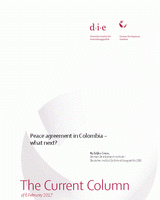Peace agreement in Colombia – what next?
Crncic, ZeljkoThe Current Column (2017)
Bonn: German Development Institute / Deutsches Institut für Entwicklungspolitik (DIE) (The Current Column of 6 February 2017)
Bonn, 6 February 2017. First, the good news: in November 2016, the Congress of Colombia ratified the peace accord between the Santos government and the larger guerilla movement Fuerzas Armadas Revolucionarias de Colombia (FARC). Negotiations will begin in February with the Ejercito de la Liberación Nacional (ELN), the smaller left-wing guerilla group.
The conflict in Colombia, which began in the mid-1960s, cost thousands of people their lives and forced over four million of them to flee their homes. The length and complexity of the war was reflected in the time-consuming negotiations, which began in Havana in 2012 and culminated in the adoption of the peace agreement. This four-year process was accompanied by many highs and lows. Ceasefires were announced and then broken, local politicians kidnapped and freed again, and guerrilla commanders killed. It was uncertain until the last minute whether a peace accord would emerge, as the government wanted to gain legitimacy for the agreement from citizens. Eligible voters decided on the text of the agreement on 2 October 2016, surprisingly rejecting it by a slim majority. In a contrary development that week, the Nobel Committee in Oslo decided to award President Santos the Nobel Peace Prize. The accord was then finally ratified in modified form on 24 November 2016 without Congress calling another referendum.
Santos’ peace project does not enjoy universal support
It appears strange at first that a large group of Colombians would reject the peace accord, but there is a territorial reason behind this. The war between the Colombian Government and FARC was primarily centred on rural regions in which raw materials are mined or coca grown and transported. It is in these peripheral zones, some of which are highly inaccessible, that the power of the warring parties, FARC and ordinary gangs is concentrated. For decades, the civilian population in these areas bore the brunt of the relentless conflict. However, in the big cities, where most of the population live, the presence of the guerilla group has notably diminished in recent years. There has also been a significant reduction in the number of kidnappings on national roads, for instance. For many Colombians living in urban centres, the war is less noticeable. The guerilla fighters also have a bad reputation owing to their long-standing practice of kidnappings and other acts of violence against the population. Politician Alvaro Uribe capitalised on this situation in his campaign against the peace agreement, managing to convince a small majority of the electorate to vote against it.
‘The actual level of peace’
To date, efforts to make peace with FARC could be described as a tour de force with a stage win. We can only hope that, after decades of bloodshed, Colombian society can return to a situation of peace. The high spirits about the peace accord are being dampened by the fact that there is still a great deal to do.
The peace agreement is only the beginning of the end of the conflict in Colombia. In order to bring about long-term peace, the agreement also needs to be put into practice locally. The government must ensure that displaced persons can return to their land and live there in peace. It must see to it that FARC makes material and non-material restitution for its crimes to the civilian population (a requirement which incidentally applies to all warring parties, including the officially demobilised paramilitaries). The government is responsible for making sure that the political participation negotiated as part of the peace accord is delivered in practice. Ultimately, it must provide protection for political opponents and social activists. Let us hope that, in the long term, even those who have so far been intransigent and who voted “no” in October will become convinced of the practical benefits of peace. If the aforementioned pre-requisites are not met, the Havana peace accord will remain no more than a hard-won partial victory which could be quickly nullified by social, political and economic conditions.

